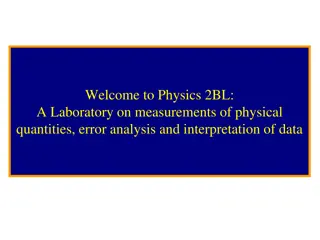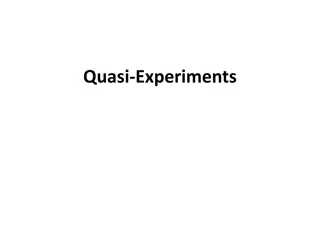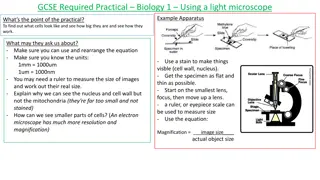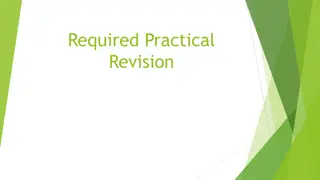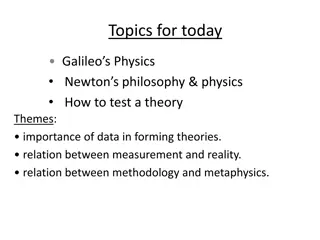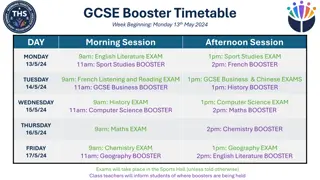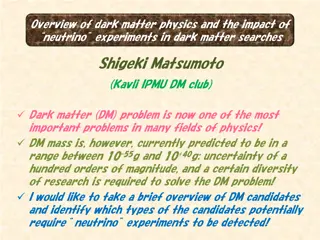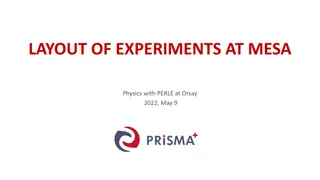GCSE Physics Practical Experiments Overview
This text provides a comprehensive overview of three GCSE required practical experiments in Physics - specific heat capacity, investigating resistance, and electrical components. It outlines the purpose of each practical, the apparatus required, key concepts, potential questions, and considerations for accurate measurements. The focus is on understanding specific heat capacity of materials, resistance in wires, and behavior of electrical components in circuits.
Download Presentation

Please find below an Image/Link to download the presentation.
The content on the website is provided AS IS for your information and personal use only. It may not be sold, licensed, or shared on other websites without obtaining consent from the author.If you encounter any issues during the download, it is possible that the publisher has removed the file from their server.
You are allowed to download the files provided on this website for personal or commercial use, subject to the condition that they are used lawfully. All files are the property of their respective owners.
The content on the website is provided AS IS for your information and personal use only. It may not be sold, licensed, or shared on other websites without obtaining consent from the author.
E N D
Presentation Transcript
GCSE Required Practical Physics 1 Specific Heat Capacity Specific Heat Capacity: the amount of energy needed to raise the temp of 1kg by 1 C What s the point of the practical? To find out the specific heat capacity of a material. (You ll need to heat it and work out how much energy has gone in.) Example Apparatus Joulemeter measures energy going into the heater in joules If you haven t got a joulemeter, but do have a ammeter, voltmeter or power meter you can work out the amount of energy by: Heater heats the block Insulation stops heat escaping into the atmosphere Energy = power x time Power = current x potential difference Thermometer measures the temperature rise Results: energy tra nsferred (J) E C) = specific capacity heat (J/kg c temperatu C) mass (kg) m change re ( What may they ask us about? Why do you need to insulate the block (to stop heat loss to the atmosphere) Why is your answer not the true value (because not all the heat was transferred into the block and through to the thermometer) Why is the temperature increase slower at first? (because it takes some time for the block to heat up and for the heat to reach the thermometer.) It may not be a block of metal. You could use a kettle to heat an amount of water or any other way of heating something. What s the resolution of temperature measurements? This experiment could be repeated and you d get slightly different readings. They could ask about repeatability and ask you to calculate the mean or the uncertainty.
GCSE Required Practical Physics 1 Investigating Resistance Resistance: how difficult it is for current to flow through part of the circuit. What s the point of the practical? To find out resistance of a wire. (You could look at different lengths of wire, different thicknesses, or even different temperatures) Example Apparatus Voltmeter: measures the potential Difference Results: resistance (W) =potential difference (V) current (A) Ammeter: measures the current The longer the wire, the more resistance The thicker the wire, the less resistance The higher the temperature the more resistance Metre stick: Measures the length of wire that the current is going through What may they ask us about? - Why must the power pack be kept on a low potential difference / What are the hazards (The wire will get very hot, could burn you) - Explain how the temperature affects the resistance (as the wire gets hot, the ions inside the wire vibrate faster so there are more collisions with the electrons cannot flow as easily) - Why is it important to switch the electricity off in between each reading (to let the wire cool down, as temperature affects resistance) - What sort of error could cause all the ammeter/voltmeter readings to be too high (a zero error the meters need to be set at zero to start with) - Resolution of measurements, repeatability, reproducibility, control variables etc etc
GCSE Required Practical Physics 1 Investigating Electrical Components (lamp, diode, resistor) Component: part of a circuit Potential Difference (V): the energy transferred to part of a circuit by each coulomb of charge Resistor: limits the current in a circuit Current: the flow of charge diode: only allows current to flow one way Example Apparatus What s the point of the practical? To find out how current and potential difference change in different components Voltmeter: measures the potential Difference Results: Ammeter: measures the current Resistor: what we re testing. (can be replaced with a lamp, then a diode Resistor lamp Diode What may they ask us about? - Explain the pattern for each component (resistor: fixed resistance more PD =more current. Lamp: more PD = more current but at high PD, the filament gets hot, ions vibrate so resistance increases and current levels off. Diode: current can only flow in one direction) - Resolution of measurements, repeatability, reproducibility, control variables etc etc
GCSE Required Practical Physics 1 Resistors in Series and Parallel Resistor: limits the current in a circuit Example Apparatus What s the point of the practical? To find out what happens to the total resistance when resistors are put in series and in parallel Results for series circuits the total resistance is the same as both resistors added up. Each time you add a resistor, you get more resistance and less current Parallel circuit Series circuit Results for parallel circuits The total resistance is less than the smallest resistor. Each time you add more resistors, the current increases and the total resistance decreases. (the are more routes overall for the current) What may they ask us about? - Why aren t your results completely accurate? (because the meters aren t completely accurate, the power pack potential difference fluctuates slightly, the temperature of the wires changes which affects resistance) - What is the resolution of measurements? (e.g. 0.41A, 0.32A, 0.39A are all to 0.01 resolution) - They may ask you to calculate resistance, current or PD. Or ask what happens if you add/take away resistors.
GCSE Required Practical Physics 1 Resistors in Series and Parallel Resistor: limits the current in a circuit Example Apparatus What s the point of the practical? To find out what happens to the total resistance when resistors are put in series and in parallel Results for series circuits the total resistance is the same as both resistors added up. Each time you add a resistor, you get more resistance and less current Parallel circuit Series circuit Results for parallel circuits The total resistance is less than the smallest resistor. Each time you add more resistors, the current increases and the total resistance decreases. (the are more routes overall for the current) What may they ask us about? - Why aren t your results completely accurate? (because the meters aren t completely accurate, the power pack potential difference fluctuates slightly, the temperature of the wires changes which affects resistance) - What is the resolution of measurements? (e.g. 0.41A, 0.32A, 0.39A are all to 0.01 resolution) - They may ask you to calculate resistance, current or PD. Or ask what happens if you add/take away resistors.
GCSE Required Practical Physics 1 Calculating Density Density = a substance s mass per unit volume. What s the point of the practical? To find out the density of different materials. Cubes of material are easy for volume (length x width x height). For irregular shapes, you need a eureka can to work out the volume Example Apparatus Results Volume (cm3) Material Mass (g) Density (g/cm3) Aluminium 22.3 8.0 2.79 Steel 50.2 6.4 7.84 Finding Volume Finding Mass What may they ask us about? - What is the resolution of the balance? (0.1g in this case) - How could you get errors when using the eureka can? (water may spill out of the sides if you drop the object in too quickly / there may already be some water in the measuring cylinder / the water might not be at exactly the level of the spout) - How could you get errors when weighing the object (the balance may not be at exactly zero to start with (not calibrated)) - What is the uncertainty of the measurements? (the balance has a 0.05 uncertainty here as it only goes up in 0.1 s)


